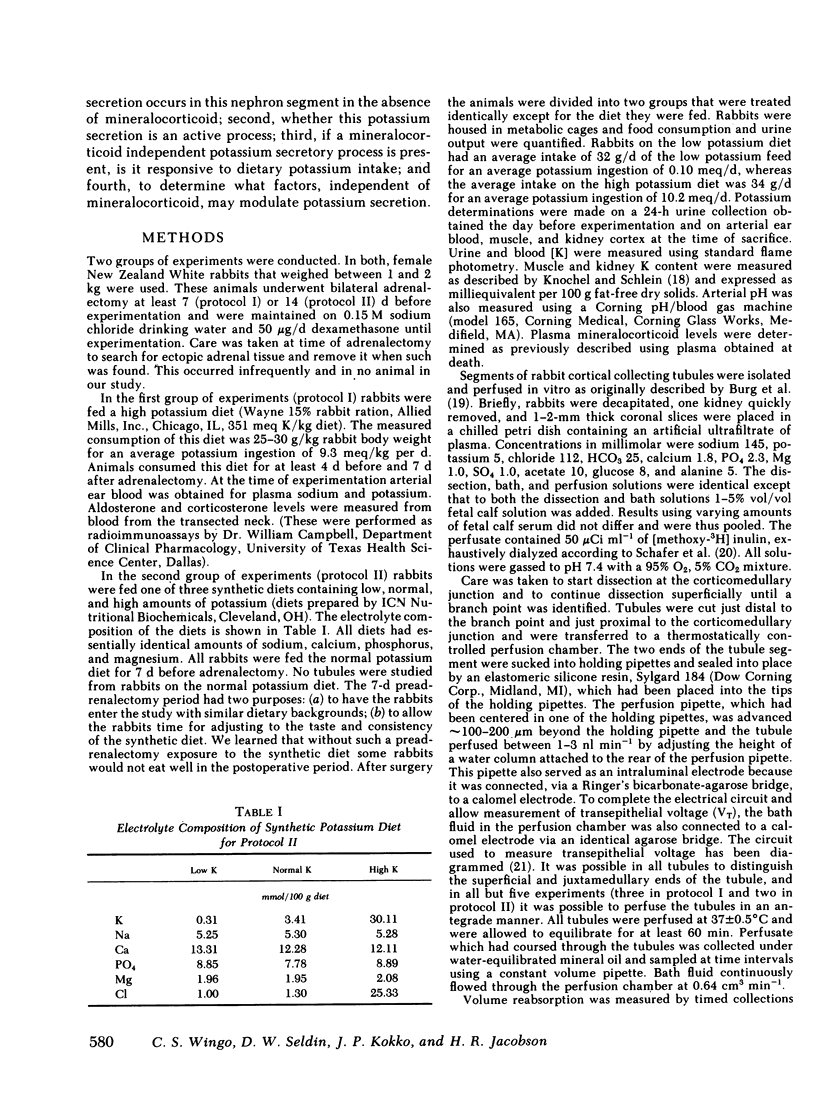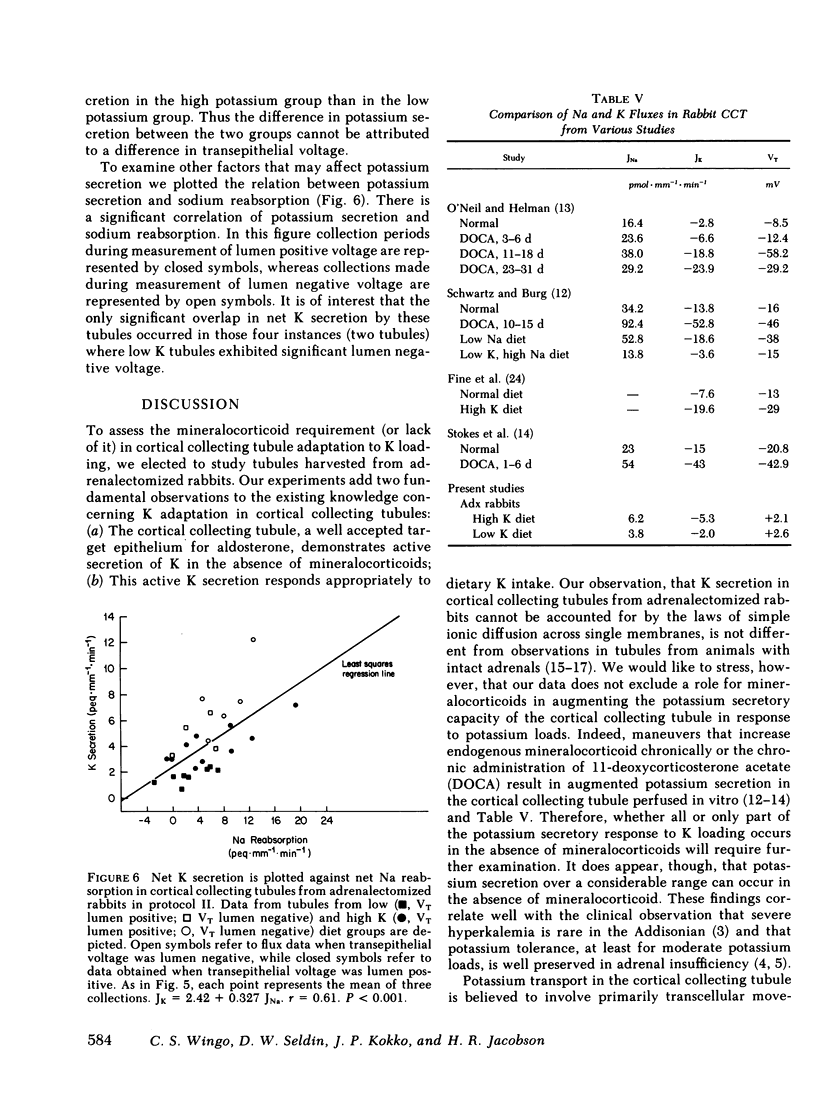Abstract
Addisonian patients can maintain potassium homeostasis despite the absence of mineralocorticoid. The present in vitro microperfusion studies examine what role the cortical collecting tubule might play in this process. All studies were performed on tubules harvested from adrenalectomized rabbits, which were maintained on 0.15 M NaCl drinking water and dexamethasone 50 μg/d. Perfusion and bath solutions were symmetrical Ringer's bicarbonate with [K] of 5 meq/liter. Initial studies on cortical collecting tubules from adrenalectomized animals ingesting a high potassium chow (9 meq K/kg body wt) demonstrated net potassium secretion against an electrochemical gradient (mean collected fluid [K] 16.5±2.6 meq/liter with an observed transepithelial voltage of −6.3±4.1 mV; predicted voltage for passive distribution of potassium being −28.2 mV). To examine whether this active potassium secretion could be modulated by dietary potassium, independent of mineralocorticoid, two diets identical in all respects except for potassium content were formulated. Potassium secretion was compared in cortical collecting tubules harvested from adrenalectomized animals on low (0.1 meq K) and high (10 meq K) potassium intake.
Mean net potassium secretion by cortical collecting tubules was 2.02±0.54 peq mm−1 min−1 in the low potassium diet group and 5.34±.74 peq·mm−1·min−1 in the high potassium group. The mean transepithelial voltages of the collecting tubules did not differ between the two dietary groups. While net Na reabsorption was significantly greater in tubules from the high K group, this could not account for the differences in K secretion. These data demonstrate that: (a) the cortical collecting tubule can actively secrete potassium and that the magnitude of this potassium secretion correlates with potassium intake; (b) this active potassium secretory process in independent of mineralocorticoid. These findings support the hypothesis that the cortical collecting tubule may contribute to K homeostasis in Addison's disease.
Full text
PDF







Selected References
These references are in PubMed. This may not be the complete list of references from this article.
- Burg M., Grantham J., Abramow M., Orloff J. Preparation and study of fragments of single rabbit nephrons. Am J Physiol. 1966 Jun;210(6):1293–1298. doi: 10.1152/ajplegacy.1966.210.6.1293. [DOI] [PubMed] [Google Scholar]
- Doucet A., Katz A. I. Renal potassium adaptation: Na-K-ATPase activity along the nephron after chronic potassium loading. Am J Physiol. 1980 May;238(5):F380–F386. doi: 10.1152/ajprenal.1980.238.5.F380. [DOI] [PubMed] [Google Scholar]
- Fine L. G., Yanagawa N., Schultze R. G., Tuck M., Trizna W. Functional profile of the isolated uremic nephron: potassium adaptation in the rabbit cortical collecting tubule. J Clin Invest. 1979 Oct;64(4):1033–1043. doi: 10.1172/JCI109540. [DOI] [PMC free article] [PubMed] [Google Scholar]
- Garg L. C., Knepper M. A., Burg M. B. Mineralocorticoid effects on Na-K-ATPase in individual nephron segments. Am J Physiol. 1981 Jun;240(6):F536–F544. doi: 10.1152/ajprenal.1981.240.6.F536. [DOI] [PubMed] [Google Scholar]
- Grantham J. J., Kurg M. B., Obloff J. The nature of transtubular Na and K transport in isolated rabbit renal collecting tubules. J Clin Invest. 1970 Oct;49(10):1815–1826. doi: 10.1172/JCI106399. [DOI] [PMC free article] [PubMed] [Google Scholar]
- Gross J. B., Imai M., Kokko J. P. A functional comparison of the cortical collecting tubule and the distal convoluted tubule. J Clin Invest. 1975 Jun;55(6):1284–1294. doi: 10.1172/JCI108048. [DOI] [PMC free article] [PubMed] [Google Scholar]
- Hayslett J. P. Potassium adaptation after reduction of nephron population. Yale J Biol Med. 1978 May-Jun;51(3):283–288. [PMC free article] [PubMed] [Google Scholar]
- Jacobson H. R., Kokko J. P. Intrinsic differences in various segments of the proximal convoluted tubule. J Clin Invest. 1976 Apr;57(4):818–825. doi: 10.1172/JCI108357. [DOI] [PMC free article] [PubMed] [Google Scholar]
- Knochel J. P., Schlein E. M. On the mechanism of rhabdomyolysis in potassium depletion. J Clin Invest. 1972 Jul;51(7):1750–1758. doi: 10.1172/JCI106976. [DOI] [PMC free article] [PubMed] [Google Scholar]
- Malnic G., Klose R. M., Giebisch G. Micropuncture study of distal tubular potassium and sodium transport in rat nephron. Am J Physiol. 1966 Sep;211(3):529–547. doi: 10.1152/ajplegacy.1966.211.3.529. [DOI] [PubMed] [Google Scholar]
- Marver D., Schwartz M. J. Identification of mineralocorticoid target sites in the isolated rabbit cortical nephron. Proc Natl Acad Sci U S A. 1980 Jun;77(6):3672–3676. doi: 10.1073/pnas.77.6.3672. [DOI] [PMC free article] [PubMed] [Google Scholar]
- O'Neil R. G., Helman S. I. Transport characteristics of renal collecting tubules: influences of DOCA and diet. Am J Physiol. 1977 Dec;233(6):F544–F558. doi: 10.1152/ajprenal.1977.233.6.F544. [DOI] [PubMed] [Google Scholar]
- Petty K. J., Kokko J. P., Marver D. Secondary effect of aldosterone on Na-KATPase activity in the rabbit cortical collecting tubule. J Clin Invest. 1981 Dec;68(6):1514–1521. doi: 10.1172/JCI110405. [DOI] [PMC free article] [PubMed] [Google Scholar]
- RELMAN A. S., SCHWARTZ W. B. The effect of DOCA on electrolyte balance in normal man and its relation to sodium chloride intake. Yale J Biol Med. 1952 Jun;24(6):540–558. [PMC free article] [PubMed] [Google Scholar]
- Rodriguez H. J., Sinha S. K., Starling J., Klahr S. Regulation of renal Na+-K+-ATPase in the rat by adrenal steroids. Am J Physiol. 1981 Aug;241(2):F186–F195. doi: 10.1152/ajprenal.1981.241.2.F186. [DOI] [PubMed] [Google Scholar]
- SELDIN D. W., WELT L. G., CORT J. H. The role of sodium salts and adrenal steroids in the production of hypokalemic alkalosis. Yale J Biol Med. 1956 Dec;29(3):229–247. [PMC free article] [PubMed] [Google Scholar]
- Schafer J. A., Troutman S. L., Andreoli T. E. Volume reabsorption, transepithelial potential differences, and ionic permeability properties in mammalian superficial proximal straight tubules. J Gen Physiol. 1974 Nov;64(5):582–607. doi: 10.1085/jgp.64.5.582. [DOI] [PMC free article] [PubMed] [Google Scholar]
- Schwartz G. J., Burg M. B. Mineralocorticoid effects on cation transport by cortical collecting tubules in vitro. Am J Physiol. 1978 Dec;235(6):F576–F585. doi: 10.1152/ajprenal.1978.235.6.F576. [DOI] [PubMed] [Google Scholar]
- Stanton B. A., Biemesderfer D., Wade J. B., Giebisch G. Structural and functional study of the rat distal nephron: effects of potassium adaptation and depletion. Kidney Int. 1981 Jan;19(1):36–48. doi: 10.1038/ki.1981.5. [DOI] [PubMed] [Google Scholar]
- Stokes J. B., Ingram M. J., Williams A. D., Ingram D. Heterogeneity of the rabbit collecting tubule: localization of mineralocorticoid hormone action to the cortical portion. Kidney Int. 1981 Sep;20(3):340–347. doi: 10.1038/ki.1981.144. [DOI] [PubMed] [Google Scholar]
- Stokes J. B. Potassium secretion by cortical collecting tubule: relation to sodium absorption, luminal sodium concentration, and transepithelial voltage. Am J Physiol. 1981 Oct;241(4):F395–F402. doi: 10.1152/ajprenal.1981.241.4.F395. [DOI] [PubMed] [Google Scholar]
- Stoner L. C., Burg M. B., Orloff J. Ion transport in cortical collecting tubule; effect of amiloride. Am J Physiol. 1974 Aug;227(2):453–459. doi: 10.1152/ajplegacy.1974.227.2.453. [DOI] [PubMed] [Google Scholar]
- Talbott J. H., Pecora L. J., Melville R. S., Consolazio W. V. RENAL FUNCTION IN PATIENTS WITH ADDISON'S DISEASE AND IN PATIENTS WITH ADRENAL INSUFFICIENCY SECONDARY TO PITUITARY PAN-HYPOFUNCTION. J Clin Invest. 1942 Jan;21(1):107–119. doi: 10.1172/JCI101272. [DOI] [PMC free article] [PubMed] [Google Scholar]


